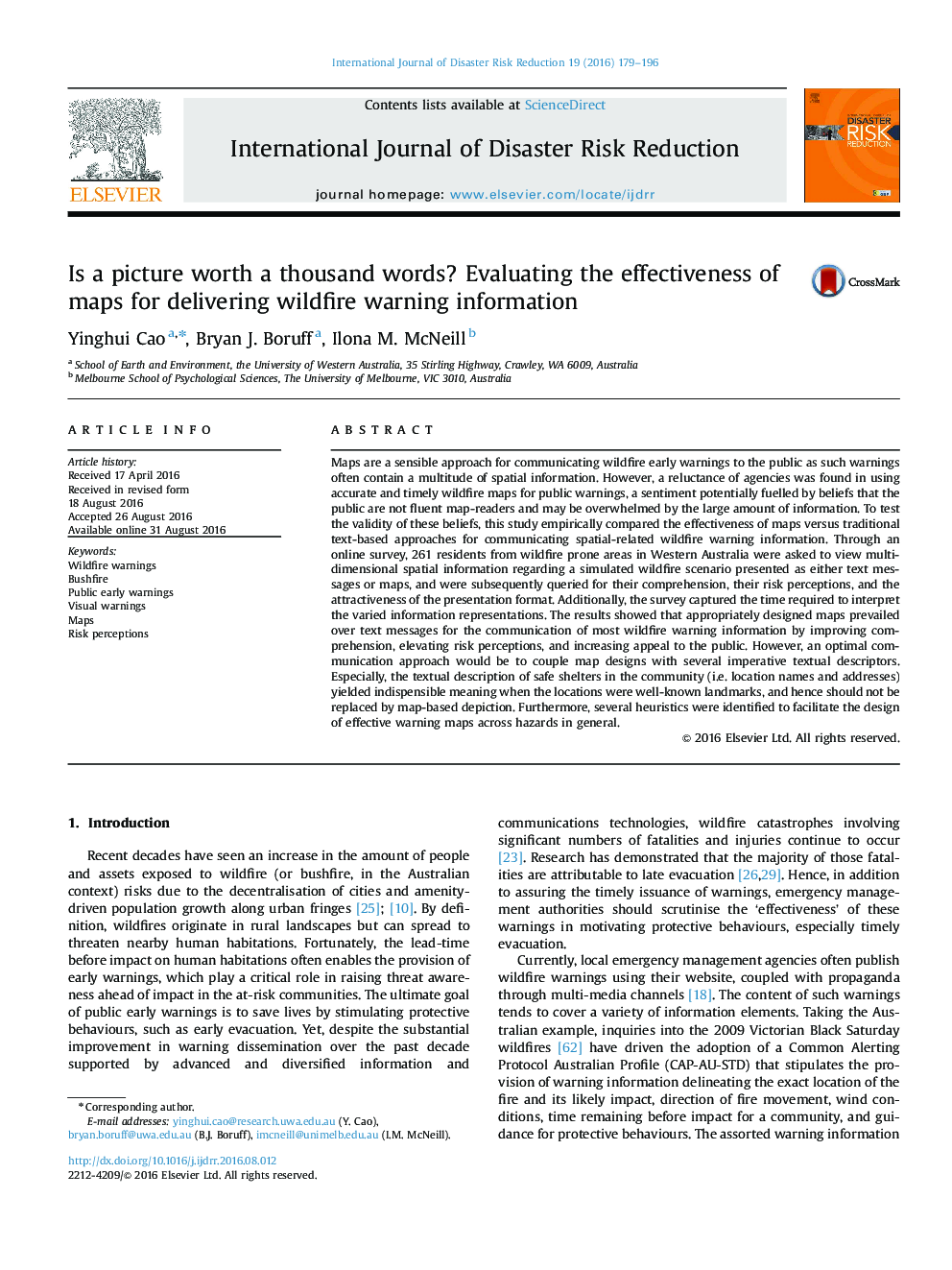| کد مقاله | کد نشریه | سال انتشار | مقاله انگلیسی | نسخه تمام متن |
|---|---|---|---|---|
| 7472381 | 1485151 | 2016 | 18 صفحه PDF | دانلود رایگان |
عنوان انگلیسی مقاله ISI
Is a picture worth a thousand words? Evaluating the effectiveness of maps for delivering wildfire warning information
ترجمه فارسی عنوان
آیا یک تصویر ارزش هزار کلمه است؟ ارزیابی اثربخشی نقشه ها برای ارائه اطلاعات هشدار آتشفشان
دانلود مقاله + سفارش ترجمه
دانلود مقاله ISI انگلیسی
رایگان برای ایرانیان
کلمات کلیدی
هشدارهای آتش سوزی، بوش فیر، هشدارها در اوایل عمومی، هشدارهای بصری، نقشه ها، درک ریسک،
ترجمه چکیده
نقشه ها یک رویکرد منطقی برای برقراری ارتباط هشدارهای زود هنگام آتشفشان به عموم هستند، زیرا این هشدارها اغلب شامل بسیاری از اطلاعات فضایی هستند. با این حال، بی توجهی از آژانس ها در استفاده از نقشه های دقیق و به موقع آتش سوزی برای هشدار عمومی یافت شد، احساساتی که به طور بالقوه با اعتقاد به این که مردم عملا نقشه خوانندگان نیست و ممکن است توسط مقدار زیادی از اطلاعات غرق شود. برای بررسی اعتبار این باورها، این مطالعه تجربی از کارآیی نقشه ها در مقابل روش های متداول مبتنی بر متن برای ارتباط هشدار آتشفشانی مربوط به فضایی مقایسه شده است. از طریق نظرسنجی آنلاین، 261 نفر از ساکنان مناطق غرق در غرب استرالیا خواسته شدند اطلاعات فضایی چند بعدی را در رابطه با یک سناریو شبیه سازی آتش سوزی ارائه شده به صورت پیام یا نقشه های متفاوتی ارائه دهند و سپس برای درک مطلب، درک ریسک و جذابیت آنها فرمت ارائه علاوه بر این، نظرسنجی زمان لازم برای تفسیر نمایندگی های متنوع را به دست آورد. نتایج نشان داد که نقشه های مناسب طراحی شده بیش از پیام های متنی برای ارتباط بیشتر اطلاعات هشدار آتشفشان با بهبود درک، بالا بردن درک ریسک و افزایش تجدید نظر به عموم به وجود می آیند. با این حال، یک رویکرد ارتباط بهینه می تواند طرح های نقشه را با چندین توصیف الزامات متناوب مرتبط کند. به ویژه، شرح متنی از پناهگاه های امن در جامعه (به عنوان مثال نام و آدرس محل) به معنای ضروری زمانی که محل نشانه شناخته شده شناخته شده بود، و از این رو نباید جایگزین با نقشه مبتنی بر نقشه. علاوه بر این، برای شناسایی نقشه های هشدار دهنده موثر در سراسر خطرات به طور کلی، شناسایی چندین شناسایی شد.
موضوعات مرتبط
مهندسی و علوم پایه
علوم زمین و سیارات
فیزیک زمین (ژئو فیزیک)
چکیده انگلیسی
Maps are a sensible approach for communicating wildfire early warnings to the public as such warnings often contain a multitude of spatial information. However, a reluctance of agencies was found in using accurate and timely wildfire maps for public warnings, a sentiment potentially fuelled by beliefs that the public are not fluent map-readers and may be overwhelmed by the large amount of information. To test the validity of these beliefs, this study empirically compared the effectiveness of maps versus traditional text-based approaches for communicating spatial-related wildfire warning information. Through an online survey, 261 residents from wildfire prone areas in Western Australia were asked to view multidimensional spatial information regarding a simulated wildfire scenario presented as either text messages or maps, and were subsequently queried for their comprehension, their risk perceptions, and the attractiveness of the presentation format. Additionally, the survey captured the time required to interpret the varied information representations. The results showed that appropriately designed maps prevailed over text messages for the communication of most wildfire warning information by improving comprehension, elevating risk perceptions, and increasing appeal to the public. However, an optimal communication approach would be to couple map designs with several imperative textual descriptors. Especially, the textual description of safe shelters in the community (i.e. location names and addresses) yielded indispensible meaning when the locations were well-known landmarks, and hence should not be replaced by map-based depiction. Furthermore, several heuristics were identified to facilitate the design of effective warning maps across hazards in general.
ناشر
Database: Elsevier - ScienceDirect (ساینس دایرکت)
Journal: International Journal of Disaster Risk Reduction - Volume 19, October 2016, Pages 179-196
Journal: International Journal of Disaster Risk Reduction - Volume 19, October 2016, Pages 179-196
نویسندگان
Yinghui Cao, Bryan J. Boruff, Ilona M. McNeill,
